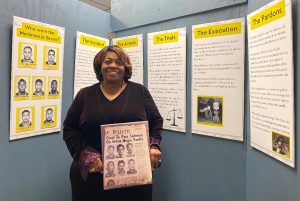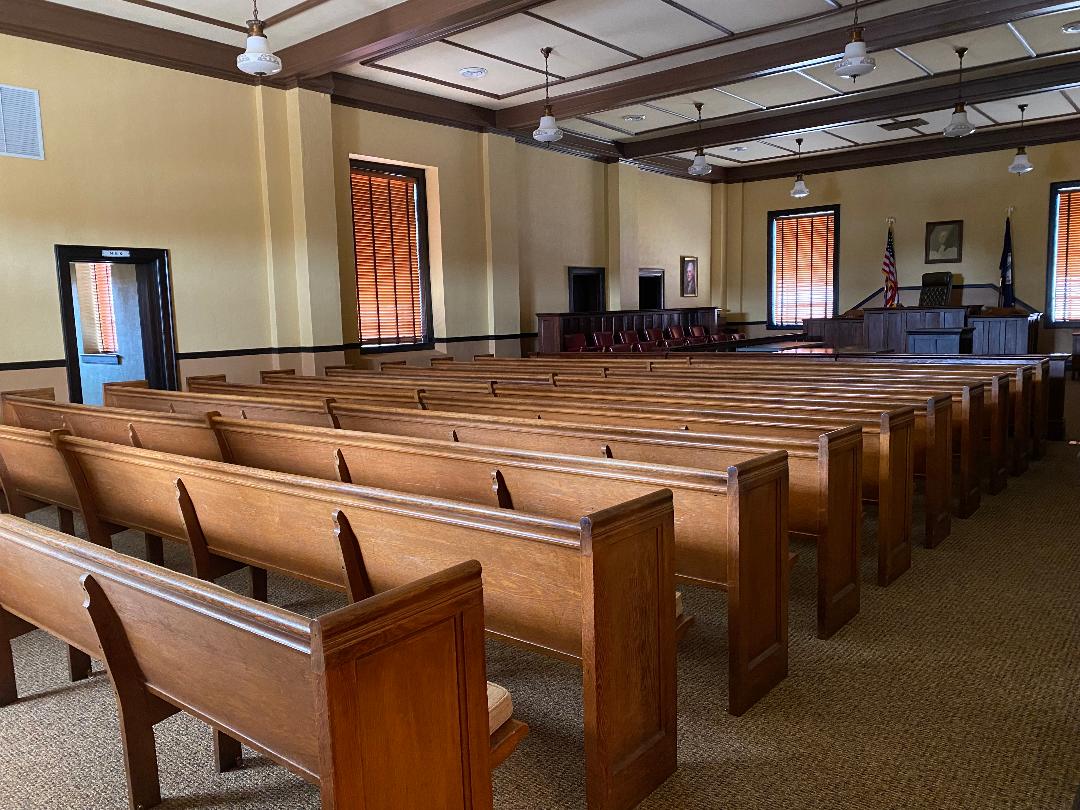
By Callie Hietala
More than 70 years after they were executed, the stories of the Martinsville Seven are finally being told by two institutions in the city the men called home.
In recent months, two displays have been installed commemorating the history of the Martinsville Seven—one at the Fayette Area Historical Initiative (FAHI) on Fayette Street and another at the Martinsville-Henry County Heritage Center and Museum on East Main Street. Both are located in Uptown Martinsville.
The Martinsville Seven were Joe Henry Hampton, Frank Hairston Jr., Howard Lee Hairston, James Luther Hairston, John Clabon Taylor, Booker T. Millner, and Francis DeSales Grayson. The seven Black men were found guilty of the 1949 rape of Ruby Floyd by all-white, all-male juries in single-day trials. They were executed in the electric chair on February 2 and 5, 1951. To date, it marked the largest mass execution for a single-victim crime in Virginia’s history.
On August 31, Gov. Ralph Northam granted each of the men posthumous pardons in an acknowledgement of the injustice of their sentences.
The exhibit at FAHI opened on Feb. 5. Faye Holland, director of the Martinsville 7 Initiative which spearheaded the creation of the exhibit, said the date was targeted because it was the anniversary of the day the last of the Seven were executed.
In addition to educating the public about this chapter in Martinsville’s history, Holland said the display lays the groundwork for future topics that will be expanded upon in subsequent exhibits—seven in all—that will tell a more complete history of the Martinsville Seven. Future exhibits will focus on the crime, the arrests, the trials, executions, and the pardons.
Another, Holland said, will delve deeper into the personal lives of the executed men.
Holland said she hopes the exhibits will give visitors greater insight into the lives of the Seven, most of whom were teenagers or in their 20s when they were arrested.
For instance, Holland said, at least two of the men—Taylor and Grayson—had children, and all left families behind who were affected by the loss of their loved one who, in some cases, also was a provider for the family.
The stories of the families and how they were affected often go overlooked, she said. “You’ve got to look at what the living (relatives) now face and how it still affects them.”
At 37, Grayson was the oldest of the group. Holland said he had four children, one of whom was just 4-years-old when his father was executed. He watched his father get arrested, Holland said. After that, the young boy and his family were socially ostracized, she said, and were left in financial difficulty in a time when services for those in need are not nearly as available as they are today.
“They had nothing,” she said. “Their dad was gone.”
While not all the surviving descendants of the men have been able to travel to Martinsville to see the exhibit yet, the reactions for those who have were overwhelmingly positive, Holland said. They see the exhibit, she said, as not necessarily a validation, but rather a recognition of their long-held feelings. “They’re all really, really glad that there is some light shed on it (the story) and there is some understanding of kinship,” she said.
One relative, she recalled, expressed a feeling of relief that “even though the situation was so horrific, now there’s recognition. There are people that take a deep breath with him because (these men) are not just ghosts, left out and forgotten forever.”
Taylor’s great grandson, Camry Harris, who still lives in the area, expressed his appreciation for the effort that went into the exhibit.
“It has been a very heavy burden that I feel may never be lifted no matter what’s done, but I am very thankful to Faye Holland and her team of researchers for the years of work they put in to present the story of my great grandfather in this exhibit,” he said. “In my heart, I pray for peace for all the families affected, including my own.”
In addition to the exhibition effort mounted by the Initiative, Holland said she hopes to one day have a dedicated museum and social justice center in Martinsville.

Just a few miles away from the FAHI exhibit, the Martinsville-Henry County Historical Society also has joined the effort to commemorate the Martinsville Seven. Visitors to the Heritage Center and Museum, located in the former Henry County courthouse, will notice a new text panel hanging just outside the courtroom where initial hearings were held for the seven men.
The panel, which divides the story into seven sections similar to those in the FAHI exhibit, includes images of some of the protests that took place ahead of the executions (the case drew both national and international attention) as well as an image of Hampton’s death certificate.
Historical Society board member Jarred Marlowe researched and wrote the panel while his friend David Scurry, a student at Yale, used his graphic design skills to put the panel together.
Marlowe said the story of the Martinsville Seven is “one of those stories I just can’t shake.”
“It’s hard to fathom the injustices that took place in the local, state, and national justice system during that time, and even though they had repeated legal appeals and the legal system had many chances to examine the cases and trial, nothing was ever corrected,” he said.
Marlowe is a regular volunteer at the museum, an experience that, he said, makes the story of the men hit home even more. “At least once a week, I walk into the courtroom where seven young black men ultimately had their lives ended by a prejudiced and unfair system. While working on the display, it was hard not to be haunted by their faces and stories. It just motivated me to want to do more.
“I wish more people knew or would want to learn more about them, to not only show how much things have changed since then, but as a lesson that we can never go back to a point like that again,” Marlowe said. “The Martinsville Seven, to me, serve as a stark reminder that racism and prejudice was not some far off problem that others deal with, and we only hear about. It happened here, in our city, with our neighbors. And we’re still reeling from it in this day and time.”
“It was my honor and privilege to help make that board and I want to do more for them in the future,” he said.
Board president John Phillips said the group “took our time on the Martinsville Seven project to ensure that we respected the sensitivity and accuracy of the subject.”
“Though long overdue, the permanent exhibit is quite timely as I question whether our entire community could have embraced it earlier. I’ve lived here my entire life and never heard of the Martinsville Seven until several years ago,” he said. “As a historical society and museum, we are responsible for nearly 250 years as an organized people and many more years as a culture. We cannot be proud of what happened but are honored to finally and publicly acknowledge the Martinsville Seven as part of our overall history. As American author Robert Heinlein stated, ‘A generation which ignores history has no past and no future.’”
A third commemoration of the Seven is planned later in the year. City Attorney and Assistant City Manager Eric Monday sponsored a state historic marker, which will be placed outside of the former courthouse that is now home to the Heritage Center and Museum. Monday said a dedication ceremony is set for August 27 of this year, just a few days before the one-year anniversary of the pardons.




